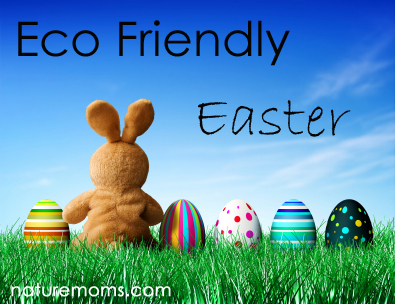I don’t know about you but this time of year when I go to the store and see lots of plastic Easter grass, plastic eggs, and huge chocolate bunnies… it makes the environmentalist in me cringe? This is the big green mom conundrum… how to make holidays fun for our kids without leaving a large mark on our planet. Lucky for us though there are numerous ways to make Easter green without festooning our lovely planet with fake grass!
1. Give your children a decorative cloth bag with a set of child’s garden tools, seeds, or other gardening supplies instead of an Easter basket. You can put a few eggs in it with seeds and it can even contain “instructions” from the easter bunny asking your child to help plant spring flowers for bunnies and children everywhere to enjoy. Kids will LOVE getting a special assignment.
2. If you still want to go with a traditional basket, choose eco-friendly materials such as cotton, hemp, or jute. Or purchase hand-made, fair trade certified baskets that you can find other uses for after Easter (how about toy storage?). Thrift stores usually have baskets this time of year too (I know mine does)… used is better than new! Also, you can make your own Easter basket from materials around the house, such as hand-decorated bags, totes, wastebaskets, laundry baskets, etc.
3. Fill the Easter baskets with biodegradable, sustainable materials that can be composted, such as natural straw, hay, moss, or simply grass from outside. It is really easy to grow your wheat grass in the house, so start now to have some ready by Easter. You can also shred up the Sunday funnies or colorful scrap paper or shred some of those colorful catalogues and magazines that come in the mail. Kids won’t mind.
4. Make your own treats for the basket instead of buying the processed junk – make some raw cookies or brownie balls or dehydrate some fruit.
5. Re-use what you have. This is our secret weapon. We bought Easter stuff a few years ago from.gif) yard sales and thrift stores mostly and we keep it all in a box in the garage. This includes everything from plastic and ceramic eggs, baskets, and Easter decor. We even have an Easter egg wreath made using leftover Easter eggs from years past and a Christmas wreath we got at a yard sale. We made it about 4 years ago now and it is still one of my kids favorite Easter decorations. If you already have plastic grass, use it as a base for a centerpiece or a creative springtime scene.
yard sales and thrift stores mostly and we keep it all in a box in the garage. This includes everything from plastic and ceramic eggs, baskets, and Easter decor. We even have an Easter egg wreath made using leftover Easter eggs from years past and a Christmas wreath we got at a yard sale. We made it about 4 years ago now and it is still one of my kids favorite Easter decorations. If you already have plastic grass, use it as a base for a centerpiece or a creative springtime scene.
6. Decorate using scrap paper and junk mail – cut out bunny shapes and string them onto colorful yarn, or cut out Easter shapes into a chain. You can also use leftover felt or fabric scraps to make cloth eggs or to make stuffed bunnies. Cloth scraps can be used to make a decorative banner with felt letters thats says “Happy Easter”.
7. For your Easter feast eat bunny food. Serve cut vegetables, fruit, and maybe some dandelion greens in a green smoothie.
8. Dye eggs using natural easter egg dyes -mix a tablespoon of white vinegar per cup of boiling water and add onion skins (yellow), red cabbage (light purple), shredded raw beets (deep red), spinach (light green), coffee grounds or tea (brown), etc.
9. Get your eggs from a local farmer or urban chicken-keeper. If the eggs are brown, you can use eco-friendly paints on them instead of dyes. Also try blowing the eggs first so they can be kept for future years. Wooden eggs or knitted eggs are another good option as are some new Eco-Eggs Easter Egg Coloring Kits that you can buy.
 10. Fill your children’s Easter baskets with enduring sustainable toys (puzzles, cute games), a deck of cards, dominoes, bunny books, etc. Take your child’s personality into consideration rather than just giving the “usual” stuffed bunny and plastic trinkets. Then you can build a basket theme around your child’s interests.
10. Fill your children’s Easter baskets with enduring sustainable toys (puzzles, cute games), a deck of cards, dominoes, bunny books, etc. Take your child’s personality into consideration rather than just giving the “usual” stuffed bunny and plastic trinkets. Then you can build a basket theme around your child’s interests.
All of these ideas will help reduce waste this Easter season while preserving the “fun”. What is your best green easter tip?

